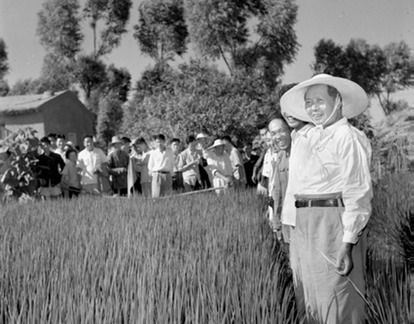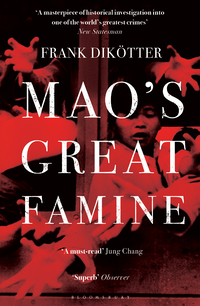Food Security, 15 January 2011
This book stands out from other accounts of the famine inflicted on China from 1958-61 on account of its basis in recently opened archives and in the countless compelling details which are provided to clarify the interlocking themes of the text. The scope of the text is enormous but it returns repeatedly to the stories of individual villages and villagers, people whose letters of complaint are recorded in archives across China.
The communist leadership in China was impatient for social advance and sought to pioneer a new form of development: economic progress on the two simultaneous fronts of agricultural production and industrial output. The Soviet Union was set on overtaking the US in steel production and China’s leaders did not want to be left behind. Rather than wait for improved primary production to enable industrialisation at some point in the future, they wanted to introduce a new form of dual development. Under Mao’s leadership this had been tried in a preliminary way in the mid-1950s with very limited success. But rather than draw the lesson that a rapid and two-fold process of development was not viable, Mao and like-minded leaders assumed that the problem had been that the process had not been tried systematically enough. Half-heartedness had been the problem.
From 1958 he introduced the Great Leap Forward. To say that Dikötter finds this set of policies entirely misguided is an understatement. What the text documents is that there was a nearly perfect storm of poor policy, mindless implementation and concealment of errors.
As is reasonably well known, the supposed secret to the two-fold development was to improve agricultural productivity radi cally and thereby release labour from the countryside to develop an infrastructure and boost industrial production even in rural areas. From the outset this underperformed woefully, in part because some agricultural innovations (deep ploughing, changes in cultivation, and multiple sowing to promote high yields) were based on misleading ideas ham-fistedly put into practice. It was also because labour was taken off the land in clumsy and misguided ways: people were detailed to work, for example, on dams or other projects at the wrong season or too far from their base to allow them to achieve both objectives, even if they could manage to put in the hours without exhausting themselves.
Tragically, this went beyond the merely mistaken into the preposterous for two additional reasons. Mao and his closest supporters were determined that the scheme must work out. Those who offered criticisms ran the grave risk of outing themselves as “rightists”. Even to point out weaknesses in the logic was enough to get one into deep trouble. Accordingly, those seeking political success played along with the favoured ideology. On paper, all was going to plan. Almost at no level did anyone dare speak out. Second, to impress their bosses, districts competed with each other to present ever higher output targets, targets which they then had to (appear to) meet. When the harvests were not as high as had been projected, party bureaucrats still tried to deliver the promised amounts of food to the cities or for export. Inevitably, if targets were up, production down, and foodstuffs were being shipped from the countryside, food became scarce first in agricultural areas. If shortfalls were officially recognised they tended to be blamed on people who were undermining the communist system – farmers who were allegedly concealing grain or putting in hard work only on small private plots. Of course, many sensible people were trying to conceal food so these individualistic explanations could often be supported with evidence of finds. This created the rationale and context to intensify the radical collectivisation. Consolidation of farmland would allow land to be managed in a rational manner and would also make plentiful labour available for deployment in the common good. The elderly and children could be looked after in common facilities, food provided in canteens and then less time would be consumed by inefficient domestic labour. All would benefit.
But these experiments produced their own absurdities and horrors. Collectivisation was rightly seen as the loss of one’s crops and animals to the system, so people slaughtered their pigs and ate them before the meat was lost to the collective machine. Farm collectivisation was thus commonly marked by a sudden depletion of rural resources. Much worse, the collectives were often run by party cadres in a ruthless manner. The situation was perfect for the encouragement of fervour. To get on one had to promise to increase productivity and the only way to do that was to exploit people more ruthlessly than before. Only heartless managers could prosper, even if that meant the use of beatings and violence against your own labourers. Dikötter documents how the canteen system was used to punish those who resisted collectivisation. Canteens were effectively a monopolisation of the food supply so resistance was fought with the threat to withhold food. Since the managers had an immediate interest only in raising production, food for the elderly or the sick was in some sense a waste of resources; conditions in facilities for the elderly and for children were often beyond terrible.
The industrial component of the strategy was similarly flawed. The fetishised goal of increasing iron production saw small furnaces established in rural areas in which people melted down spare iron. These commonlyproduced iron of inferior quality and—in a hideous irony—the furnaces were sometimes fed with household implements deemed unnecessary now that canteens provided communal services. The industrial strategy thus complemented collectivisation and further removed individuals’ resources. At the same time the state had, notes Dikötter, gone on a shopping spree for industrial and military purposes which, with infamously poor Chinese iron in its manufactures, could only be paid for with agricultural exports.
The entire system demanded and rewarded ruthlessness. But it also provided lots of opportunities for corruption and informal abuse. Canteen workers for example might slyly eat their fill. Collectives might raid other others’ fields or livestock in order to try to meet their targets. Access to food was traded for sex. Robbery and fiddling were apparently widespread. Things were organised little better in the cities. Although urban dwellers were supposed to fare better in terms of food supplies, the distribution was marked by terrible inefficiencies and the canteen system in factories led to the same problems. Food for workers was often appalling and (in a terrible echo of Woody Allen’s famous joke) available only in small quantities. Factories, docks and warehouses were brought low by the absurdities of the command economy and corruption.
In the middle of this the central planners were initially assured of the success of their Great Leap. On paper the economy was doing marvellously and Mao boasted to his Soviet peers of the success, even suggesting that shortly the Chinese people would be struggling to eat the vast amounts of food being produced. Commitments were made to send food to other socialist countries and to trade food with capitalist economies for the industrial inputs that were required.
According to Dikötter’s account, when reports reached Mao of failures and even of hunger he tended to disbelieve them or merely acknowledge that there might be occasional difficulties. Having survived a protracted and desperate civil war, with large causalities on both sides, the idea that some people might fall victim to this battle to transform Chinese society was not entirely implausible. Mao would speak of losing one finger in ten; in a vast country some losses could be borne.
Dikötter follows the story to its sad end; eventually the problems become undeniable and the Party slowly repositions itself but not in time to avert millions of deaths. Mao attracts some criticism but is able either to claim that he was poorly informed or to face down the critics. As Dikötter notes, many ordinary Chinese imagined that Mao had to be on their side and felt that, if only their stories could have got through to him, policies would have changed. The reader of this book will not end up sharing this comforting view.
Throughout, this book tells the story in vivid detail, drawing helpfully on examples from villages or individual Chinese. Thus, Dikötter notes how records indicates that many common illnesses were not necessarily those associated with malnutrition but those which arose from poor care and terrible hygiene in the children’s nurseries or from appalling workplace conditions. The strategy of using individuals’ stories conveys the horror of the famine period with great immediacy, though it is sometimes hard to work out how representative the events are. Reading these accounts, it is often hard to see how anyone survived.
The book finishes with a sort of reckoning and a note on sources. Earlier estimates of the death toll were likely low, in part because of the sources used. Dikötter calculates it far higher. In the end Mao’s “one finger in ten” might not have yielded too much of an over-estimate, with one in ten or fifteen of the entire population having perished.

